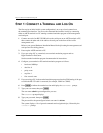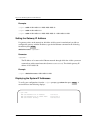
Chapter 1: Avidia System Configuration and Management Overview
Avidia System Configuration and Management User Manual 9
If you replace a management card, you can save the configuration files stored in the line and
channel card RAM to the management card NVRAM. However, the management card
configuration file containing all of the system profile information will be lost. Therefore, before
replacing a management card, back up all of the configuration files from NVRAM, then restore
the files onto the new management card.
How Hardware Profile Files are Used
A hardware profile text file (for example, amcprof.txt) is stored on each line, channel and
management card. This file contains the hardware serial numbers and version numbers for the
card. You can view this information using the command-line interface (see “Displaying System
Inventory” on page 364) or the Web interface (see “Displaying System Inventory” on
page 588). You cannot edit this information.
MANAGEMENT TOOLS AND PROTOCOLS
Avidia systems use the following management tools and protocols, which enable you to perform
management tasks such as system configuration and performance monitoring:
• SNMP (Simple Network Management Protocol)
• TFTP (Trivial File Transfer Protocol)
• FTP (File Transfer Protocol)
• Telnet (for command-line interface access)
• HTTP (HyperText Transfer Protocol - for Web interface access)
• MIBs (Management Information Bases)
• Traps
As soon as you make configuration changes, the information is saved to RAM
on the management card and each of the cards affected by the configuration.
The changes are lost if you unplug or reboot the management card or any of
the cards affected by the configuration before you save the configuration
changes to NVRAM. You must proactively save the configuration change to the
management card NVRAM using the Save command in either the Web interface
or the command-line interface.


















